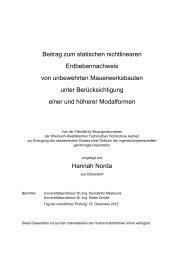Ion Beam Treatment of Functional Layers in Thin-Film Silicon Solar ...
Ion Beam Treatment of Functional Layers in Thin-Film Silicon Solar ...
Ion Beam Treatment of Functional Layers in Thin-Film Silicon Solar ...
Create successful ePaper yourself
Turn your PDF publications into a flip-book with our unique Google optimized e-Paper software.
6 <strong>Ion</strong> beam treatment <strong>of</strong> the TCO surface<br />
H a z e<br />
0 .6<br />
0 .4<br />
0 .2<br />
0 .0<br />
Z n O o n A r/O tre a te d<br />
2<br />
te x tu re d g la s s<br />
A r/O tre a te d<br />
2<br />
te x tu re d g la s s<br />
4 0 0 6 0 0 8 0 0 1 0 0 0 1 2 0 0<br />
W a v e le n g th [n m ]<br />
(a) Haze<br />
In te n s ity [r. u .]<br />
1 0 -2 Z n O o n A r/O tre a te d<br />
2<br />
te x tu re d g la s s<br />
1 0 -3<br />
1 0 -4<br />
1 0 -5<br />
1 0 -6<br />
A r/O tre a te d<br />
2<br />
te x tu re d g la s s<br />
1 0 -7<br />
0 2 0 4 0 6 0 8 0<br />
A n g le [ o ]<br />
(b) Angular resolved scatter<strong>in</strong>g (ARS)<br />
Figure 6.24: Haze (a) and ARS (b) <strong>of</strong> the Ar/O 2 treated textured glass (solid squares)<br />
and the ZnO:Al films grown on Ar/O 2 treated textured glass (open circles).<br />
α <strong>in</strong>dicate that both the ZnO:Al film becomes rougher than the textured glass both <strong>in</strong><br />
large and small scale.<br />
Fig. 6.24 gives the haze and ARS measurements <strong>of</strong> the two samples, <strong>in</strong> which the<br />
textured glass is shown <strong>in</strong> full squares and the ZnO:Al film grown on the textured<br />
glass is shown <strong>in</strong> open circles. The ZnO:Al film has nearly two times higher haze at<br />
wavelength range 350 − 800 nm. The significantly <strong>in</strong>crease <strong>of</strong> haze at short wavelength<br />
region is contributed by the small texture <strong>of</strong> ZnO:Al film. At the rest <strong>of</strong> the wavelength<br />
range, the haze <strong>of</strong> the two samples are similar. The ARS curves also have difference at<br />
the angle range <strong>of</strong> 18 − 90 ◦ . ZnO:Al film scatter more light to the large angle region.<br />
It can be concluded that for the ZnO:Al films, the peak at 7 ◦ is contributed by the<br />
textured glass substrate, while the high light scatter<strong>in</strong>g <strong>in</strong> the angle range <strong>of</strong> 30 − 90 ◦ is<br />
contributed by the as-grown textured ZnO:Al films. Therefore, with the double texture<br />
features, more light can be scattered to large angles.<br />
6.5.4.3 ZnO:Al films on cleaned textured glass<br />
This section exam<strong>in</strong>es the growth <strong>of</strong> ZnO:Al film on cleaned textured glass. Similar to<br />
the previous sections, a standard ZnO:Al film was etched <strong>in</strong> 0.5% diluted HCl solution<br />
for 90 s, then the textured ZnO:Al film was dry etched by Ar ion beam to remove all<br />
ZnO:Al material. Afterwards, the textured glass was re-cleaned by the standard clean<strong>in</strong>g<br />
process. F<strong>in</strong>ally standard ZnO:Al film was deposited on the textured glass. The growth<br />
<strong>of</strong> ZnO:Al film shall be different to the Ar or Ar/O 2 treated textured glass as expected<br />
from the experiments on flat glass <strong>in</strong>vestigated <strong>in</strong> Section 5.2.2. In the follow<strong>in</strong>g, the<br />
AFM images and the optical properties <strong>of</strong> textured glass and ZnO:Al film are studied.<br />
Fig. 6.25 shows the AFM images <strong>of</strong> cleaned textured glass (a) and the ZnO:Al films on<br />
the glass (b). The textured glass exhibit a large fraction <strong>of</strong> flat bottom due to the long<br />
162















